It sounds like a question reserved for some post-apocalyptic box office thriller: would you rather be the hunter or the hunted?
Of course, now that terms like “pandemic”, “quarantine”, and “lockdown” are appearing in the actual news instead of just Hollywood cinema, we may be closer than it seems to a world where it’s chase-or-be-chased by brain-hungry zombies, unwitting coronavirus carriers, or panic buyers looking to swipe your last roll of toilet paper.
But whether it’s in real life, works of fiction, or even simulations, it’s still an interesting question to ponder.
Since my childhood, I’ve always had my own clear-cut answer.
In games of tag during recess or around the neighborhood, I much preferred chasing to being chased. As the scrawny kid who was never as strong or as fast as the others, it was out of self-preservation that I’d want to chase someone else — even if I never caught them — than inevitably be reeled in by one of the big kids.
Over the years, chase scenes have even cameoed in my nightmares, and in them, I’m always the one being pursued, usually Hunger Games-style with my life on the line. There’s nothing like waking up covered in sweat when you haven’t even been running!
I’m sure there is some complicated fight-or-flight psychology at work there, but it must be hard-wired within my brain, because my preference has always carried over to sim racing as well.
The original NASCAR Heat game had a set of “Beat the Heat” challenges inspired by real-world situations, and I was always most frustrated with the ones that required managing old tires or a dwindling fuel load while holding off a snarling pack behind me.
Granted, as my iRacing career progressed, I came to appreciate — and even embrace — the art of fuel saving as a sneaky strategy call. I stole a few wins that way during my oval racing tenure, and I’ve generally been a loyal footsoldier of fuel saving for my team in endurance events.
But heading into last weekend’s iRacing 12 Hours of Sebring, my long-time teammate Karl Modig and I decided we’d run the race just for fun, aiming for perhaps a top-five finish, and the thought of saving fuel or tires didn’t seem like much fun to either of us.
In practice, we had tried double-stinting tires but found our Mercedes AMG GT3 was so abusive on the rubber — down to 60% tread remaining on my front tires over a run — that it just didn’t seem like a viable option for the race.
In any case, being on fresh tires every stint would let us do the chasing if one of our foolhardy opponents, we figured, was bold enough to stay out on old tires.
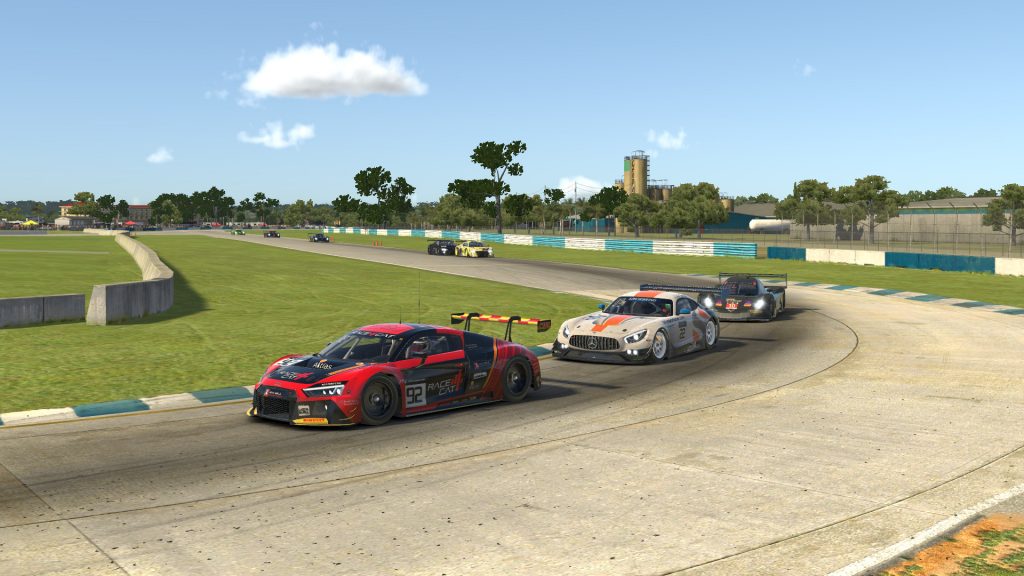
A Shaky Start
Race day arrived and we found ourselves starting thirteenth in class after my steady but not spectacular qualifying effort. But with 12 hours ahead, we had plenty of time to move up, and Karl did exactly that during the first two hours.
Problems in traffic particularly for some of our competitors in the Audi R8 — seemingly the quicker of the two GT3 cars — as well as an improved race pace relative to our qualifying speed helped us snatch up several positions and even move into the top five.
However, a pair of spins by Karl inside the final three laps of his second stint cost us around fifteen seconds and dropped us to seventh. While the rear wing damage after he eased into a tire barrier was insignificant, we worried that such an unsteady car on older tires, even that early in the race, could be troublesome for the hotter hours ahead.
Next was my turn in the car, and to my relief, I found myself with mostly clear track ahead and a surprising lack of traffic from behind. That let me settle into a consistent rhythm, although my pace still left me wanting more in our competitive class that seemed to have no slow drivers inside the top ten.
In particular, one of the cars Karl had managed to pull away from in his opening stints, the #9 Kinetic Racing Mercedes, had changed drivers during their second stop like we had. Their new driver, Marc Torres, was running three to four seconds behind me, and he was matching my pace or even exceeding it with no signs of making a mistake.
In the battle between our teams that would end up raging for the next six hours, I was the one who blinked first.
Late in my first stint, a Daytona Prototype was passing me through the tight, high-speed Bishop kink. He completed the pass into the braking zone for Le Mans, but as I tried to fall in behind him, I realized he wasn’t as far ahead as I expected and I clipped his right rear.
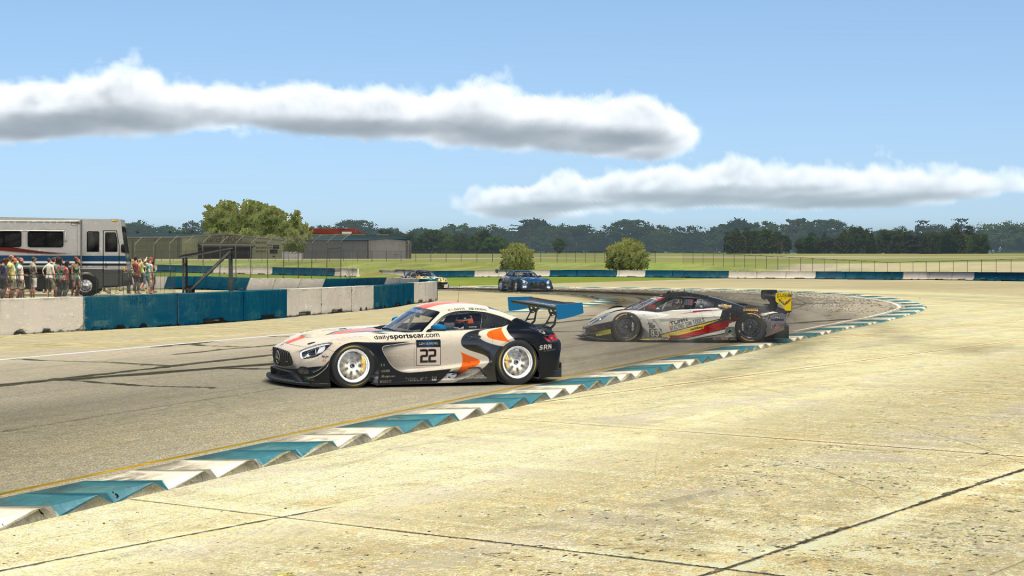
That sent him spinning, thankfully not into the wall, but unfortunately back onto the track and into my car, where he returned the favor — unintentionally, it seems — and we both spun.
In this incident compared to Karl’s earlier ones, the time loss was much more significant. Between getting the car pointed in the right direction and waiting for traffic — including our newfound opponent in the #9 — to pass by, I had lost around 20 seconds and more than erased any subtle gains I might have made on the cars ahead during the traffic-free start to the stint.
As I handed off to Karl, we were toward the back of the top ten and more than half a lap behind the pair of leading Audis. But with more than eight hours remaining, we simply had to take it one stint, one position, and even one lap at a time.
That started with him chasing down the #9 car again. Although he didn’t complete the pass on track, during the next cycle of pit stops and driver changes, we managed to get past them, but only just.
As I took the reins once again, the gap back to Marc was less than two seconds, and on the warmer track, he seemed to have a pace advantage, so he quickly closed the gap.
Still shaken from my incident in the previous stint and with a fast driver chasing me down, it was literally the stuff of my nightmares.
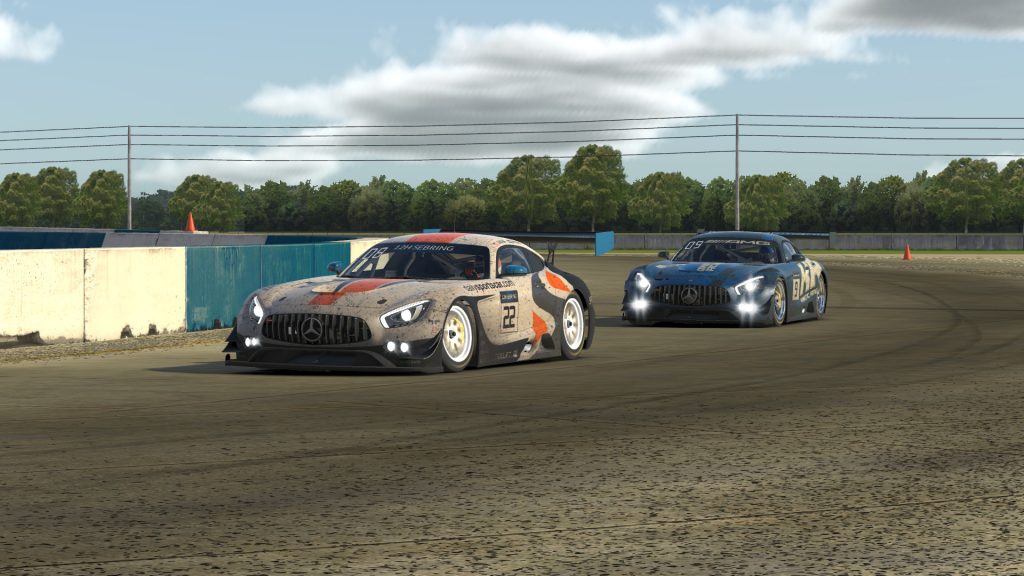
Thrill of the Chase
Traffic worked for and against each of us; every time he seemed to get slowed down and I opened a margin of a second or so, I would catch a bad break with a lapping car and lose all of my advantage.
However, he never got close enough to make a pass, and as the first half of that double stint ended with me still in front, I was both shocked and proud that I had held him off for so long.
After each of our pit stops, the battle resumed with me barely in front, but this time, I could only hold the position for a few corners. All through practice, the hairpin at turn 7 seemed like a potential trouble spot, since a late downshift to first gear before turning in gave some extra, and at times unwanted, rotation.
Just after Marc exited the pits, still on my back bumper, I nearly spun at the hairpin and only saved the car by diverting it onto the grass. That let Marc get by and put me about three seconds behind him, although after my second confidence-shattering mistake of the race, he might as well have been three minutes ahead. Either way, I figured, I’d never catch him.
As Karl stepped off the pit box to take a break — a necessity when duoing a race this long — I’m sure he expected to come back and see Marc driving off into the distance. Frankly, I did too.
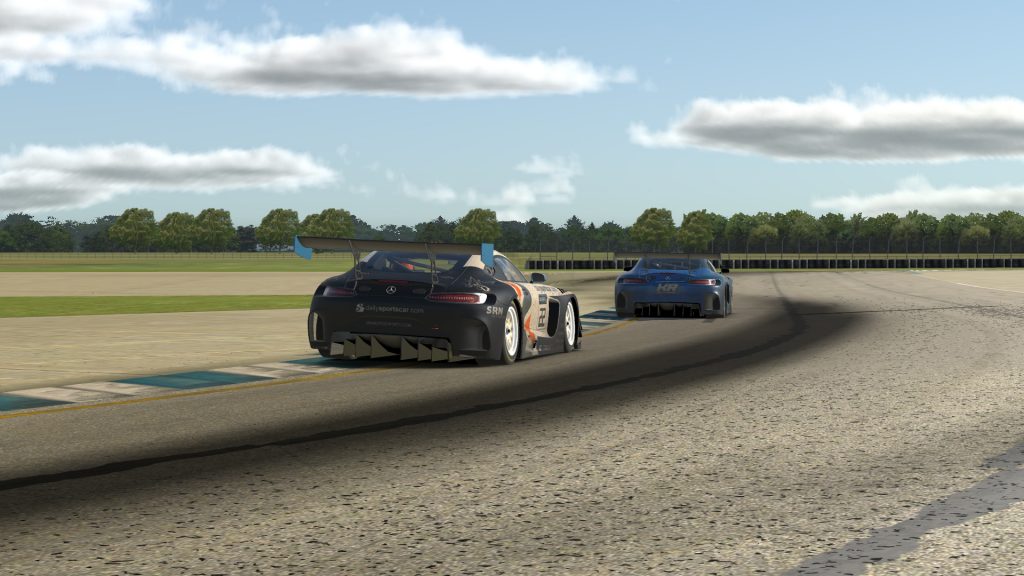
But instead, like the protagonist in so many blockbuster movies, in a moment of weakness — behind and frustrated — I suddenly found strength.
Maybe it was just being back inside my comfort zone, giving chase instead of being chased. Or maybe getting passed offered a chance to regroup after one of my hardest stints of endurance driving ever, at least that early in a race.
In any case, with little help or harm from traffic, I slowly began closing the gap. It might have only been a tenth or two per lap, but after a handful of laps, the gains were clear, and like any good hunter, I began to identify the strengths and weaknesses of my opponent.
As Marc told me in our cordial post-race discussion, he noticed them as well.
“It was gripping to see the delta teeter back and forth depending on the corner,” he said. “I would typically gain a tenth or two in the first half of the lap, and you were quick to gain it back towards the end coming onto the back straight.”
Half a stint of recovery, reconnaissance, and reducing the gap put me within striking distance of Marc, and when traffic finally interrupted our battle, I was prepared to pounce.
Entering the hairpin, a late-diving GTE car and an approaching Daytona Prototype forced him off-line and onto the marbles accumulated after more than 200 laps of racing. His bobble let me get a run into Cunningham corner that followed, and in my predator-like aggression, I drifted a bit wide of the apex and we briefly banged doors.
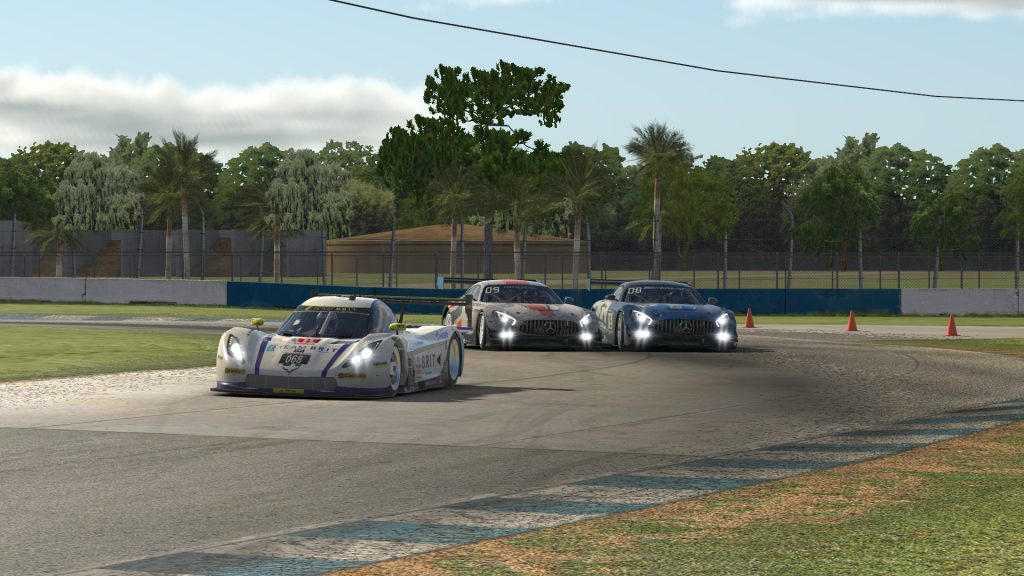
He managed to stay in front after that encounter, but later in the lap, I used my strength — and his weakness — through Le Mans to get a run and pass him down the backstretch, which he seemed to facilitate.
Perhaps he was worried a more damaging encounter might ensue if we continued such close-quarters battling. In the moment, he said it was a time of frustration, although he later took a more positive view of our fight.
“Of course, during the race I spattered something angrily, but during our post-race team chat, I immediately praised you and Karl for giving us a great battle,” Marc said.
Whether by domination or intimidation, I was back in front, and this time, I was able to match or better his pace to slowly open up a gap. But just as quickly as multi-class traffic had helped me take the spot, it worked against me and forced me to lose it.
Four laps after passing Marc, we entered turn 1 with the track blocked ahead of us by three crashing cars. As the first on the scene, my only option was to weave around a sliding Audi onto the gravel and grass.
When Marc arrived moments later, the track had opened up again and he stayed on the pavement to re-take the spot.
It was a split-second letdown after the stint-long buildup to the crescendo of our fight together, and in the remaining laps, I couldn’t get back to his bumper with my tires apparently beaten and bruised by our earlier battle.
Still, there were some inspiring takeaways from my double stint. Despite the undramatic ending, my confidence in my own driving had been restored, and rather than worrying about our team’s pace or standing in class, I was able to focus on a single competitor and at least keep that car within sight, which seemed impossible just two hours before.
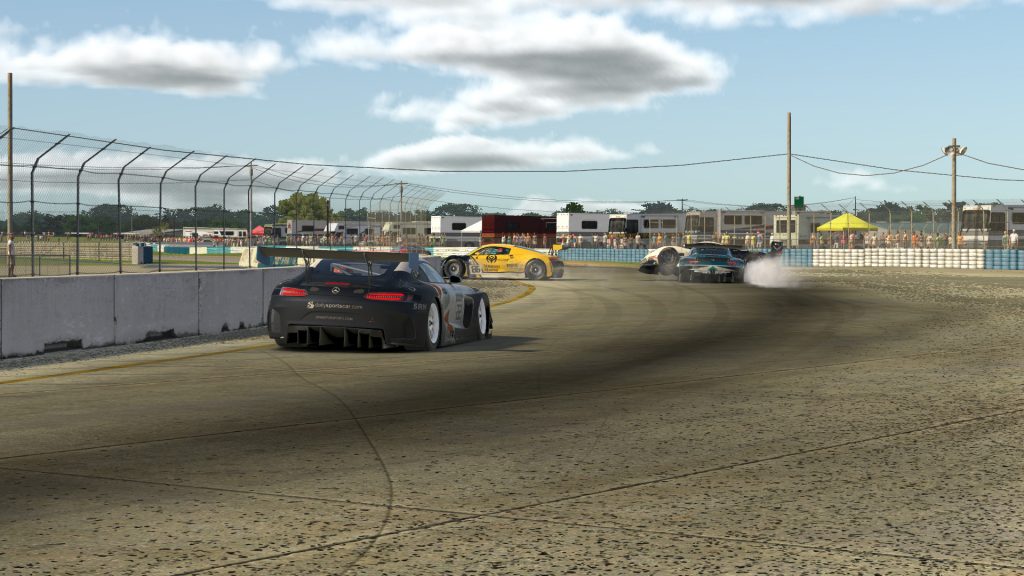
Calling an Audible
Nevertheless, approaching the two-thirds mark of the race when Karl got back behind the wheel, we were still in seventh place and without a solid plan for the final five stints.
Worringly for us, while we were at times struggling to make our tires last a single stint, some of our GT3 competitors in the Audi R8 were double stinting their tires.
During the hottest part of the afternoon, it didn’t seem like the best strategy — I would watch their cars slip and slide around, struggling with a lack of grip where the rubber met the road — but as the track was cooling down, their losses on old tires turned to gains and we began to realize that it could be a strategy we’d be forced to try.
At first, I tried to deny that reality. Based on the tire wear we had seen in our practice sessions, attempting to make them last two stints seemed like a suicide mission.
“If we’re just in this race to have fun,” I told Karl, “then I’m changing tires every stop, because driving on old tires is not fun.”
But fun or not, when our race-long rivals from the #9 car — the team we’d likely have to beat for a top five — went for a fuel-only stop, we had no choice but to follow their lead.
“It’s all gonna come down to strategy, lap times, mistakes,” I said.
“Mm hmm,” Karl concurred. “But I’ll leave you to the darkness.”
If we were destined to crash and burn, then at least we would do it together. Karl and I agreed that we would each do a double stint to close out the race, and since his tire wear had been marginally better in practice, he would go first while the track was a few degrees warmer and there was still some ambient light amid the setting sun.
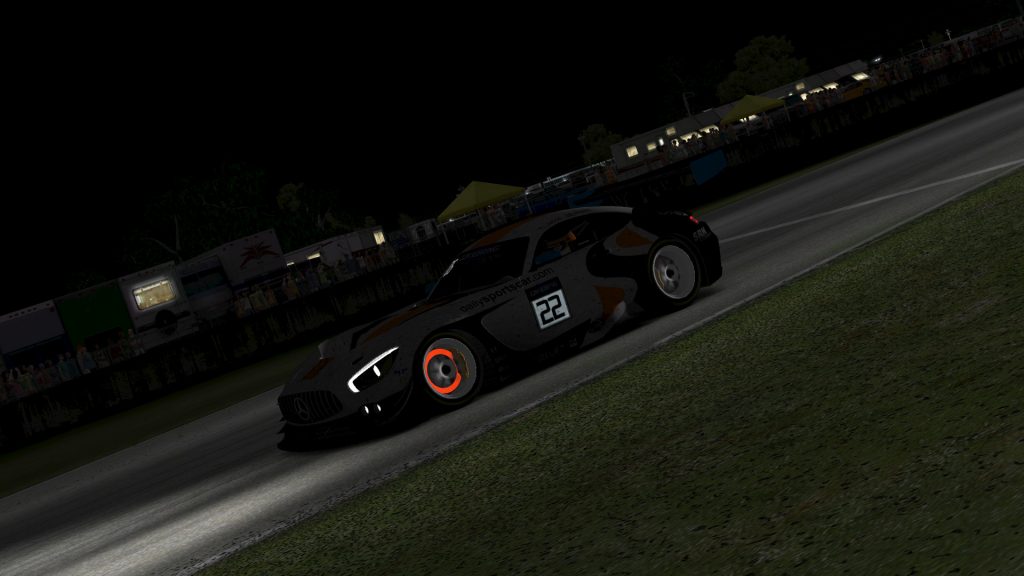
The early results were promising. His lap times on old tires were less than a second off of his pace from the previous stint, and at that rate, we would lose less time than if we’d waited another 30 seconds or so in the pits for new tires.
But halfway through the stint, pushing that old rubber became unwieldy, and Karl overdrove turn 2, sliding through the grass and bouncing off the same tire barrier he’d backed into earlier in the race.
The damage was relatively minor — another kink in the rear wing plus a banged-up right front, which he said might have caused a slight loss of downforce. We assessed that our top speed was largely unaffected, so with our car tankier than Karl’s own self-confidence, he finished out the stint uneventfully.
Before I took over for the drive to the checkered flag, he did give me a warning. The older tires didn’t tolerate much trail-braking, he indicated, and to prevent wear in my first stint, it was probably best to avoid it then as well.
With that advice squarely in the front of my mind, I proceeded with caution and quickly noticed how much I typically trail-brake in a GT3 car, even if I never realized it. In almost every corner, I found myself leaning on the brake pedal after turning in, which was a habit I’d have to break and in a hurry if I wanted to have any rubber left after the final 50 laps.
With a bit of trial and no major errors, I got used to rolling through the corners to keep the load off the front tires, and I even found some speed. Late in my stint, I set an out-of-the-blue, slightly draft-aided lap of 2:00.276, which was our team’s fastest of the race.
Before my stint, I told Karl to warn me if I started lapping too quickly, but in this case, he let it go. That’s because the situation around us had rapidly changed in the intervening hour or so.
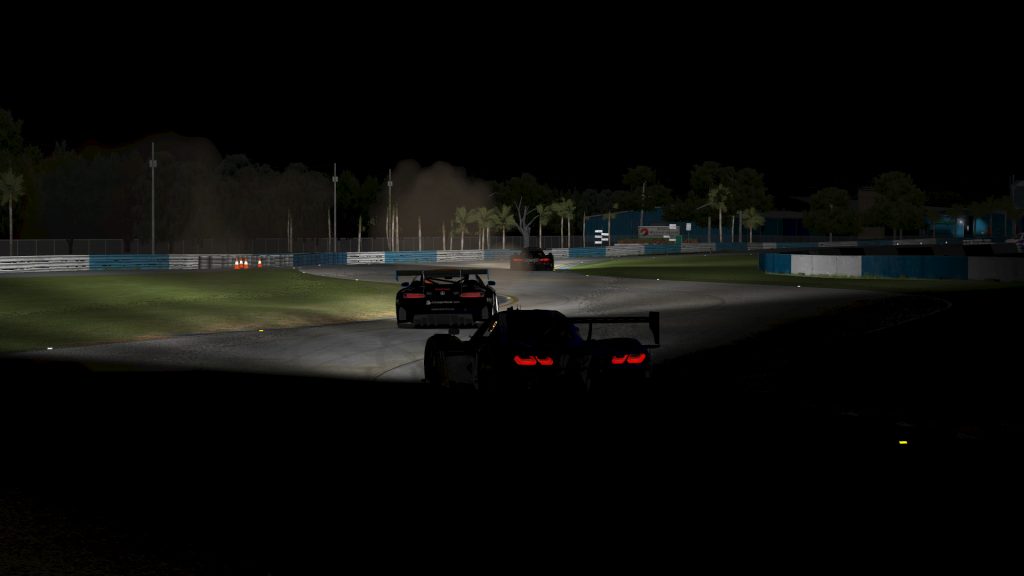
Chasing in the Darkness
Our opponents from the #9 team had crashed and fallen more than a lap behind us while making repairs, so fifth place seemed secure as long as we didn’t suffer the same fate. We then set our sights on fourth place: an Audi team who had lost time with a couple of their slower drivers in the car.
With their ringer back behind the wheel and sitting around 11 seconds behind me, we had the advantage on track, but the strategy favored them since they could take much less fuel in their final stop.
In addition, once we pitted, I’d be running slower with more fuel in the car, and I’d have to make my older tires last longer than their team would.
In a sense, it was like entering another chase, but instead of fighting bumper to bumper where I could see my opponent at all times, it was more like a guerilla mission through the jungle, knowing he was out there probably gaining ground, but hoping I could limit my losses and evade him for one more hour in the dark of night.
I asked Karl not to tell me his lap times for fear that I’d push too hard trying to match them and crash. So after taking fuel but no tires, I entered a stint of mostly radio silence, clicking off decent laps in the 2:01s while I imagined my competitor half a lap away was setting PBs in the low 2:00s.
With 12 laps to go, the silence finally broke.
“I guess you’ve seen that the 106 car exited the pits about 20 seconds ahead of you?” Karl asked.
I hadn’t, so the news came as a bit of disappointment. But it shouldn’t have been surprising. With such a short fuel fill needed, they beat us by 20 seconds just in the pits, not to mention the second-per-lap or so that they gained on track.
As their driver continued running quick laps late in the race, it was also clear that I wouldn’t have stood much of a chance in a head-to-head fight against him. That made for an anticlimactic end to the race — no last-lap pursuits or door-banging battles for position — but in a way, that wasn’t a bad thing.
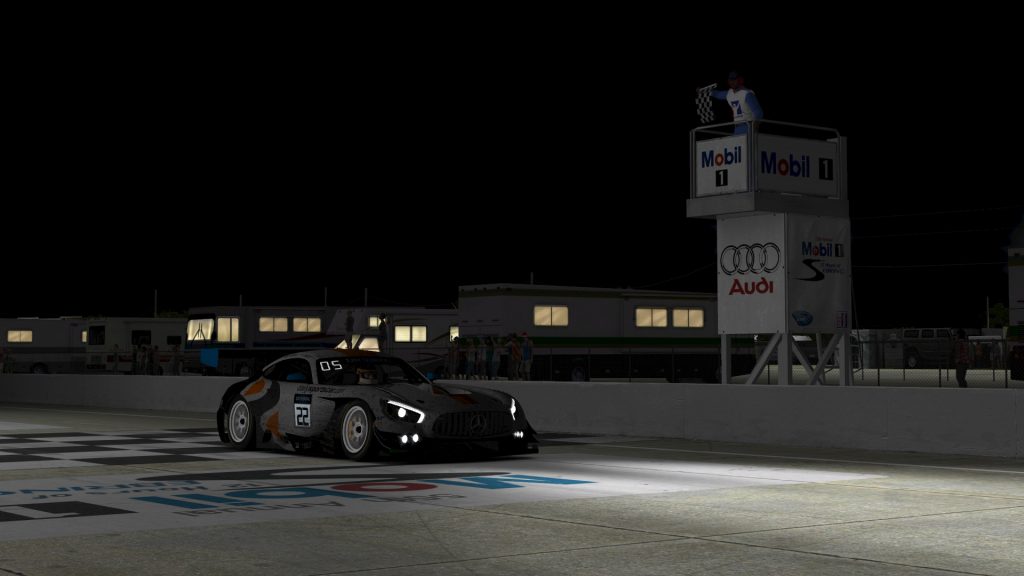
The final gap to fourth place was nearly 30 seconds: more than the time we lost from any of our individual mistakes, whether it was Karl’s detours into the turn-2 tire wall, my own trips through the grass with Marc hot on my trail, or my tandem tangle with a Daytona Prototype.
So while it wasn’t the most flawlessly executed race, neither of us could blame the other or even ourselves for costing us a position.
In fact, I was proud of our performance considering that as a team, we achieved our goal of a top-five while driving the apparently disadvantaged of the two GT3 cars. And as a driver, I had met the challenges of keeping up with and even passing a quick competitor and learning a bit of a new skill in managing my tire wear over a double stint.
One thing this race didn’t change was my preference in a pursuit. I’d still rather do the chasing any day, but I do have a new respect, and maybe some new confidence, when I’m being chased, at least in a sim race.
Marc seemed to agree.
“I’m definitely more comfortable chasing than being chased, but it’s something I’ve been working on,” he told me. “I’m actually happy when being chased so I can keep improving under that circumstance.
“Gotta keep working on checking the mirrors without focusing on them and losing sight of apexes.”
My battle with Marc is certainly the main memory I’ll take from this race, and fortunately, I didn’t have any spooky ones haunting me after the checkered flag.
In a good night’s sleep following the race, I avoided nightmares of being chased by Marc Torres, coronavirus zombies, or toilet paper hoarders.
After the news and events of recent days, that seems like a win in itself.